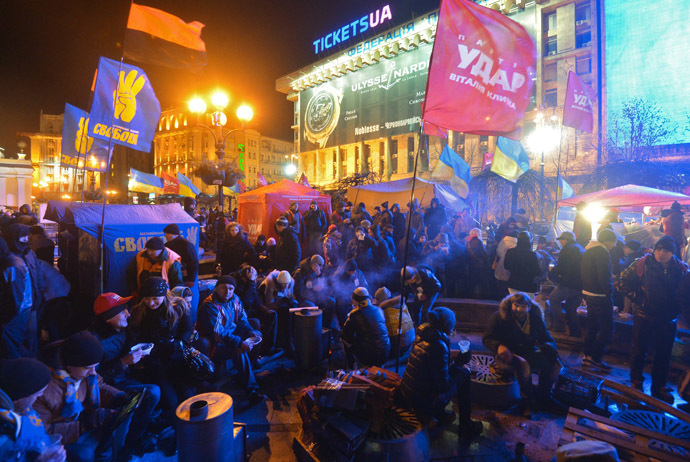Kiev & Bangkok protests: Spot 10 differences

Violent protests erupting in the streets of Kiev hours after European leaders ended the debate on the fate of troubled Ukraine’s integration at the Eastern Partnership summit in Vilnius come as a moment of truth for the second-largest ex-Soviet republic.
Ukraine, crippled by the fever of Euromania, is running amok as it currently passes through days of madness.
Mobs throwing stones and Molotov cocktails at riot police and capturing government buildings. A Christmas tree hastily dismantled on Independence Square to erect barricades. Young women from the FEMEN group urinating on portraits of President Yanukovich with their pink pants down -- to a groan of sheer pleasure from the crowd.
Finally, a bulldozer at the walls of the presidential administration as a symbol of the new ‘revolution’ to topple ‘inhumane regime’. These are the visible signs of one more self-proclaimed ‘European destination’ -- Ukraine.
“Ukraina tse Europa!” (Ukraine is Europe!) chants the crowd on Kiev’s Independence Square. But how credible is this European mantra?
The events in Kiev strangely coincided with violent anti-governments protests in Bangkok, where local opposition angrily demand Prime Minister Yingluck Shinawatra’s resignation.
The news of Thai anti-government protestors storming government buildings, erecting barricades and clashing with police mirrors the reports coming from Ukraine.
The similarity is so striking that at some point one is tempted to play a game of ‘Spot 10 Differences’. I can identify at least one: in Kiev today, the followers of opposition UDAR party of the world boxing champion Vitaly Klitschko wear red shirts, while in Bangkok the red shirt identifies you as a supporter of Yingluck Shinawatra’s government.
You may ask, so what? Bangkok is by no means European – it’s in Asia, isn’t it? Right! So the events in Thailand can pour cold water on the hot heads of the enthusiasts of Ukraine’s integration with Europe. What is happening at the streets of Kiev also evokes reminiscences with this year’s violent protests in Cairo. However, Egypt is not in Europe either. It’s one of the troubled Arab Spring states.
Some may say that a more appropriate and closer parallel would be with another ex-Soviet republic – tiny Kyrgyzstan, which from time to time finds itself possessed by the devil of ‘street revolution’.
This is a time when one ruling clan becomes impatient to oust another. It is at this point that the crowds headed by local clan leaders smash windows in government offices and break into the president’s office to exercise ‘the will of people’. While the symbol of ‘democratic revolution’ in industrial Ukraine is a bulldozer, in tribal Kyrgyzstan it’s a horseman.

The leaders of the moderate Ukrainian opposition, making their headquarters out of the premises of one of the captured government buildings in Kiev, say they have nothing to do with the ‘provocateurs’ who are clashing with police. They insist that those people belong to some obscure ultra-nationalist groups and don’t represent the broader public movement.
They go as far as to say the provocateurs are paid by the embattled Ukrainian government in a desperate move to discredit the ‘civilized protesters’ in the eyes of Europe.
However, who is going to draw a line between ‘civilized’ and ‘uncivilized’ protesters? Both of them rushed to the streets to defy the democratic choices of other Ukrainians – the legitimacy of the elected government. Is this the European way to change leadership, based on EU values of democracy and supremacy of law?
It is not only the Ukrainian opposition, which hardly shares the values of the ‘European family of nations’ and scarcely meets the criteria of European governance. So is the Ukrainian leadership, which seemingly failed to pass the test at this critical juncture of history, maneuvering between Moscow and Brussels like an elephant in the room?
Where is President Yanukovich at a time when the protests are spreading like a forest fire and one region after another is staging its own act of disobedience? Why is it that he didn’t address the nation to mobilize his supporters? Is he in hiding? However, the ‘missing president’ is another alarming sign, which makes Ukraine look more like Asia or Latin America than Europe.
All in all, while geographically Ukraine is located in the heart of Central Europe, calling it ‘Europe’ the way the Ukrainian opposition understands it is just wishful thinking. Probably, this is a good, spacious apartment, but it needs full European renovation with full-circle reconstruction work to be done from scratch. This is a costly exercise and who is going to pay for it?
Europe should also draw its own conclusions from current Ukrainian mess.
The statements, views and opinions expressed in this column are solely those of the author and do not necessarily represent those of RT.
The statements, views and opinions expressed in this column are solely those of the author and do not necessarily represent those of RT.













